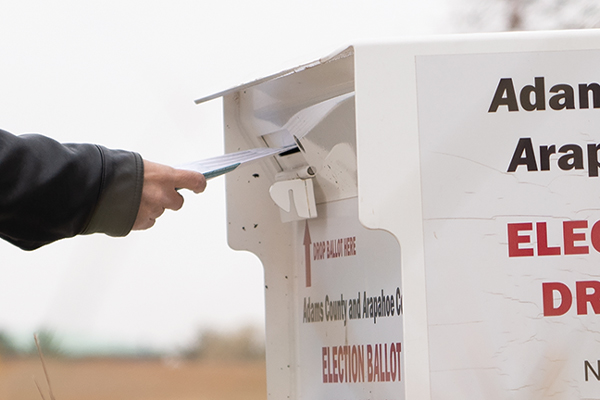DENVER | Located in the San Luis Valley, the Center School District serves nearly 600 students, most from families that don’t earn a lot of money. Farmland in the valley also does not generate much property tax revenue.
The center struggles to pay for extras like musical instruments and essentials like a high school math teacher or a trained teacher to support more than 40% of students learning English. Key staff positions remain vacant for years.
Colorado school districts with more property wealth often lead voters to approve additional taxes to raise teacher salaries, support art and music programs, or hire more counselors and nurses. But a property tax increase known as the factory tax waiver that would generate $235 per student in Denver would only raise $58 per student in the property-poor center.
A bill from the Colorado legislature aims to address one of the most vexing inequities in school funding by creating a state matching program to boost local tax efforts in low-tax districts and low median income. Proponents liken it to the popular and successful BEST program that provides matching grants to build schools in districts that couldn’t raise enough money on their own.
Aurora Public Schools is considered a “low property wealth” district and has been asking voters for decades to pass property tax increases for funding, often with success.
“A student’s zip code should not determine their educational opportunities, and at present, due to the factory tax replacement opportunity, funding really depends on the wealth of the student. local property tax,” said Sen. Bob Rankin, a Republican from Carbondale and a member of the Joint Budget Committee who has been pushing for reforms for years.
Colorado actually seeks to prevent this kind of inequality by setting a minimum per-student funding level and filling in anything that basic property taxes don’t cover.
The Factory Levy Waiver System or MLO System exists outside of the primary school funding system – which is why they are called waivers – providing additional dollars on top of base funding. School districts can raise up to 25% more than their base funding—30% more in rural districts.
More districts passing waivers
The use of waivers has grown over the past decade as Colorado lawmakers withheld school funding to pay for other budget priorities, from $580 million in 2010 to $1.4 billion in 2021. But the waiver money is not distributed evenly.
A factory – $1 for every $1,000 of assessed value – can generate anywhere from $21 per student to more than $5,000 depending on the land wealth of a given community. Districts with a lot of commercial or industrial properties or a lot of oil and gas activity have a higher assessed value.
Neighborhoods that are primarily agricultural or residential — including some suburban neighborhoods that have relatively high incomes — have lower property values. Colorado taxes a much smaller portion of the market value of residential and farm properties.
In turn, school districts tend to have an easier time selling voters on small tax increases that generate a lot of money than on large tax increases that generate little money. The state matching funds proposal seeks to change this calculation.
If voters in low-housing districts agree to a tax increase, the state will pay out some of the money based on a formula that takes into account assessed value and median income.
If Center voters raised taxes by $1 million, the state would provide more than $2 for every $1 in local taxes.
In District 49 outside of Colorado Springs, where the median income is nearly twice as high but the dominance of residential property keeps total assessed value low, the state would provide about 50 cents for every dollar. local taxes.
A plan to help municipalities with the least taxable assets
The formula was developed by a working group of school district financial officers. District 49 Business Manager Brett Ridgway said it’s important to create a model that takes into account how much communities can reasonably afford to contribute to their own schools. The model neither penalizes precincts where voters opted for higher taxes, nor rewards those where voters are simply not politically inclined to support taxes.
These 30 districts have relatively low land wealth and have already enacted factory tax waivers:
Adams 12 Five Star Schools
Westminster Public Schools
Deer trail 26J
Aurora Public Schools
Walsh Re-1
McClave Re-2
North Conejos
Crowley County
Harrisson
large field
Fountain
Peyton 23JT
District 49
Miami-Yoder
plain view
Stratton R-4
Mesa County District 51
Dolores
Mancos
West End Re-2
Fort Morgan
Weldon Valley
Swing
Holyoke
Mount Vista
Sargent Re-33J
Moffat 2
Revere School District
Greeley-Evans Weld 6
Yuma
A special committee on school finances declined to approve the bill earlier this year in a split between the parties, but two Democratic members, Senator Rachel Zenzinger of Arvada and committee chairwoman Julie McCluskie of Dillon, joined Rankin in sponsoring the legislation at the end of the session.
“I could have cast a deciding vote, but I thought the more prudent approach was to continue the conversation,” McCluskie said. “We’ve been talking about factory royalty issues for years. This solution comes from the principals. It’s really important.
Republicans have raised questions about whether state dollars should incentivize local tax increases and whether this is a sustainable solution for small, high-cost districts.
“I’m not sold on the idea that creating a state match so that if an economically impoverished area takes over more and we take that money out of the economy, that’s going to help students,” the rep said. state Colin Larson, a Republican from Littleton. who sits on the special committee, during an interview.
And State Sen. Paul Lundeen, a Monument Republican, asked funders during the committee hearing if it would become another band-aid on a broken school funding system.
“How many programs have we created? ” He asked. “How many are fully funded? How many are partially funded? How many are unfunded? »
Leslie Colwell of the Colorado Children’s Campaign has been calling for factory royalty reform for years. She said the bill represents a significant change.
“It really is one of the most glaring inequalities that we have in our school system, and it has gotten worse over time,” she said. “In terms of targeted investments that would make a real difference for students, that would be my top priority.”
Funding remains uncertain
Rankin said the status quo is immoral and should be unconstitutional in a state that promises a “thorough and uniform” education for its students.
Emotional supporters cheered in the hallway after the Senate Education Committee voted 5-2 on Thursday to move the proposal forward, but it has yet to be funded. If all 72 eligible school districts took full advantage, it would cost about $165 million a year. Funding 30 eligible districts that have already passed additional taxes would cost $65 million, according to an analysis developed by the school district’s task force.
But although the co-sponsors all sit on the Joint Budget Committee, funding for the plan was not included in the budget. The Appropriations Committee agrees to allocate $20 million for a pilot program. McCluskie said it would be helpful to enshrine the program in law even if it isn’t funded until later.
Ridgway said districts would gain more from the factory tax counterpart than they would if lawmakers fully funded K-12 education.
“The districts that are affected by this are more affected than they are by the negative factor,” he said, referring to the state’s annual budget restraint. “That’s the mathematically true answer. They could use that to go to their community and say, we’ll get a good game from the state if you help us.
Center Superintendent Carrie Zimmerman said if the bill passes, she would urge her school board to ask voters for a tax increase to enjoy the game.
She would use additional funds to hire and retain more qualified teachers, including supporting a local effort to build housing for teachers. It has used a combination of long-term replacements, retired teachers, and online programs to fill its staffing gaps, but these are not permanent solutions or, in the case of online programs, even effective ones. she said.
“Funding would allow us to do things like provide housing or pay travel allowances or provide some of these benefits that would make people want to work in the profession,” she said.
Zimmerman supports the bill and thinks a factory tax waiver would have a decent chance, but she still wants the state to increase funding without forcing cash-strapped households to dig deeper.
“The community was very supportive of our link, and that’s because we received BEST funds and they saw the value in those dollars,” she said. “It’s just frustrating that the burden is always placed on our community, which is already working so hard.”
Bureau Chief Erica Meltzer covers education policy and politics and oversees Chalkbeat Colorado’s education coverage. Contact Erica at [email protected]




